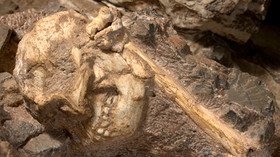Little Foot mystery solved? Scientists may have confirmed new species of human ancestor

Scientists who have studied a set of fossilized pre-human remains for the past two decades now believe they have discovered one of our ancient lost ancestors, whom they have affectionately named ‘Little Foot.’
Little Foot’s bones were found in a deep in a South African cave, Sterkfontein, northwest of Johannesburg, South Africa in 1994 by paleoanthropologist Ronald Clarke. He initially thought they were the foot bones of monkeys.
Clarke, of the University of the Witwatersrand, then painstakingly studied these bones for 20 years, excavating over 90 percent of a skeleton which was far more remarkable than he may have initially thought. The bones were embedded in an almost concrete-like substance and, in some cases, were paper-thin, hence the two-decades of painstaking excavation, cleaning, restoring and analysis.
As excavation continued, Clarke and his team believed they had found the most complete and oldest Australopithecus (early humans who lived between two million to four million years ago) fossil ever found. They eventually found that they were, in fact, mistaken.
The 3.67-million-year-old fossil (Homo sapiens appeared roughly 300,000 years ago) belonged to an elderly female, standing about 130 centimeters tall, with legs longer than her arms, a flatter face, larger teeth and a broader dietary palate than her Australopithecus.
“This hominin had longer lower limbs than upper limbs, like ourselves," Honorary University of Liverpool Research Associate in Musculoskeletal Biology Robin Crompton said. “That means it was being selected for stride length in bipedalism.”
Clarke argues that Little Foot is neither of the Australopithecus, nor A. africanus but is instead a class he has named A. prometheus.
“There are many, many differences, not only in the skull but also in the rest of the skeleton," Clarke said, comparing Little Foot to A. africanus, another of our distant ancestors.
The really intriguing element of Little Foot is that she possessed hips and femurs very similar to our own, meaning that none of her other known contemporary species walked this way, which leads scientists to now believe that this is in fact an entirely new species.
Also on rt.com Yeti or bear? DNA study debunks ‘abominable snowman’ claims (POLL)The research has yet to be peer-reviewed, however.
"This hominin, for the first time in the fossil record, had longer lower limbs than upper limbs, like ourselves,” Professor Crompton added.
“This is an important finding, as the slightly older hominin Ardipithecus, which came before Australopithecus, had longer arms than legs – more like other great apes such as the gorilla."
Think your friends would be interested? Share this story!














